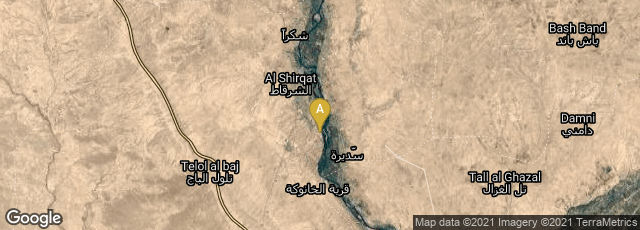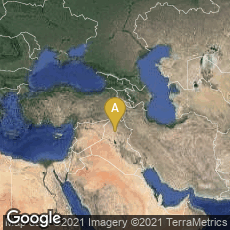

A: Al Shirqat, Saladin Governorate, Iraq
Because clay tablets, especially those baked in fires, were more durable than papyrus rolls, more original source material regarding medicine survived from Mesoptomia than from ancient Greece or Rome. Even though the amount of surviving medical textual information from Mesopotamia may be greater than what survived from Egypt, comparing the quantities of the two sources of ancient medical information is complicated since, in addition to the medical papyri which survived in the hospitable climate of Egypt, Egyptian mummies represent a unique source of paleopathological information that is not textual.
The surviving Mesopotamian medical records consist of roughly 1000 cuneiform tablets, of which 660 medical tablets from the library of Ashurbanipal are preserved in the British Museum. About 420 tablets from other sites also survived, including the library excavated from the private house of a medical practitioner (an asipu) from Neo-Assyrian Assur, and some Middle Assyrian and Middle Babylonia texts.
Most of these Mesopotamian medical tablets were not discovered until the nineteenth century, and because of difficulties with translation of cuneiform script, many of these tablets were not understood by scholars until recently. Another factor that must be taken into consideration is that since these tablets survived by unintended burial rather than by manuscript copying, and they were not preserved until comparatively recently in conventional libraries or museums, the medicine they record did not necessarily play a conventional role in the Western medical tradition. What influence their contents might have had on the practice of later physicians remains unclear.
The medical texts from Ashurbanipal's library were first published in facsimile by Reginald Campbell Thompson as Assyrian Medical Texts. From the Originals in the British Museum (1923). Franz Kocher later published six volumes called Die babylonisch-assyrische Medizin in Texten und Untersuchungen (1963-1980), the first four volumes of which contain the tablets found from sites other than Assurbanipal's library.
"The remaining two volumes of Kocher's work augment Campbell Thompson, providing new joins of broken fragments and much material uncovered in the British Museum. At least one more volume of Nineveh texts has been announced. In addition, the series Spaet Babylonische Texte aus Uruk contains some 30 medical texts not included in Kocher's work. The vast majority of these tablets are prescriptions, but there are a few series of tablets that contained entries that were directly related to one another, and these have been labeled 'treatises' " (Nancy Demand, The Asclepion, accessed 05-30-2009).
More recently the texts of many of the Mesopotamian medical tablets were translated and analyzed from the medical point of view by Assyriologist/cuneiformist, JoAnn Scurlock and physician/medical historian Burton R. Anderson as Diagnoses in Assyrian and Babylonian Medicine (2005).
•The largest surviving medical treatise from ancient Mesopotamia is known as the Treatise of Medical Diagnosis and Prognoses.
"The text of this treatise consists of 40 tablets collected and studied by the French scholar R. Labat. Although the oldest surviving copy of this treatise dates to around 1600 BCE, the information contained in the text is an amalgamation of several centuries of Mesopotamian medical knowledge. The diagnostic treatise is organized in head to toe order with separate subsections covering convulsive disorders, gynecology and pediatrics. It is unfortunate that the antiquated translations available at present to the non-specialist make ancient Mesopotamian medical texts sound like excerpts from a sorceror's handbook. In fact, as recent research is showing, the descriptions of diseases contained in the diagnostic treatise demonstrate a keen ability to observe and are usually astute. Virtually all expected diseases can be found described in parts of the diagnostic treatise, when those parts are fully preserved, as they are for neurology, fevers, worms and flukes, VD and skin lesions. The medical texts are, moreover, essentially rational, and some of the treatments, as for example those designed for excessive bleeding (where all the plants mentioned can be easily identified), are essentially the same as modern treatments for the same conditions" (Nancy Demand, The Aesclepion, accessed 05-30-2009).